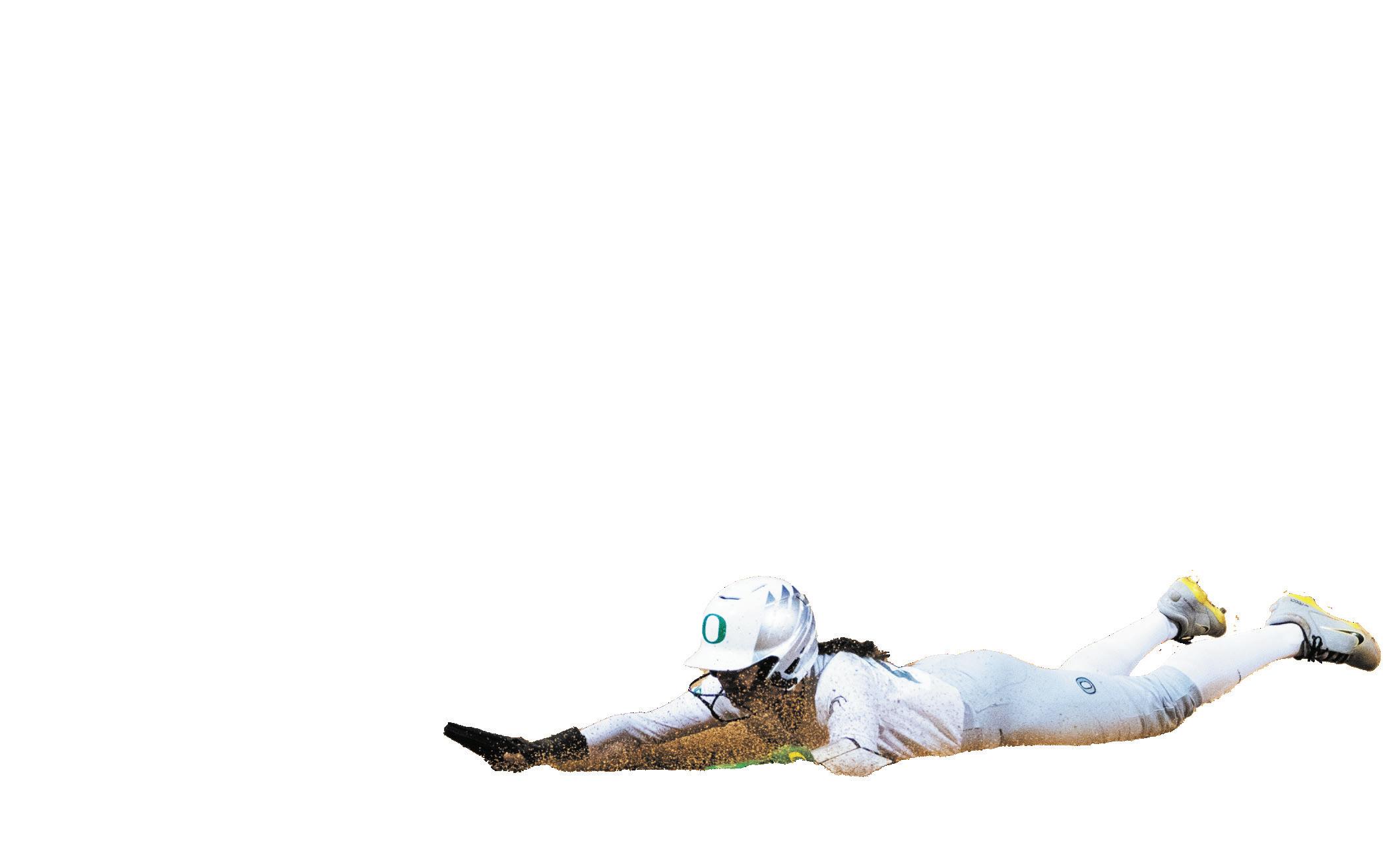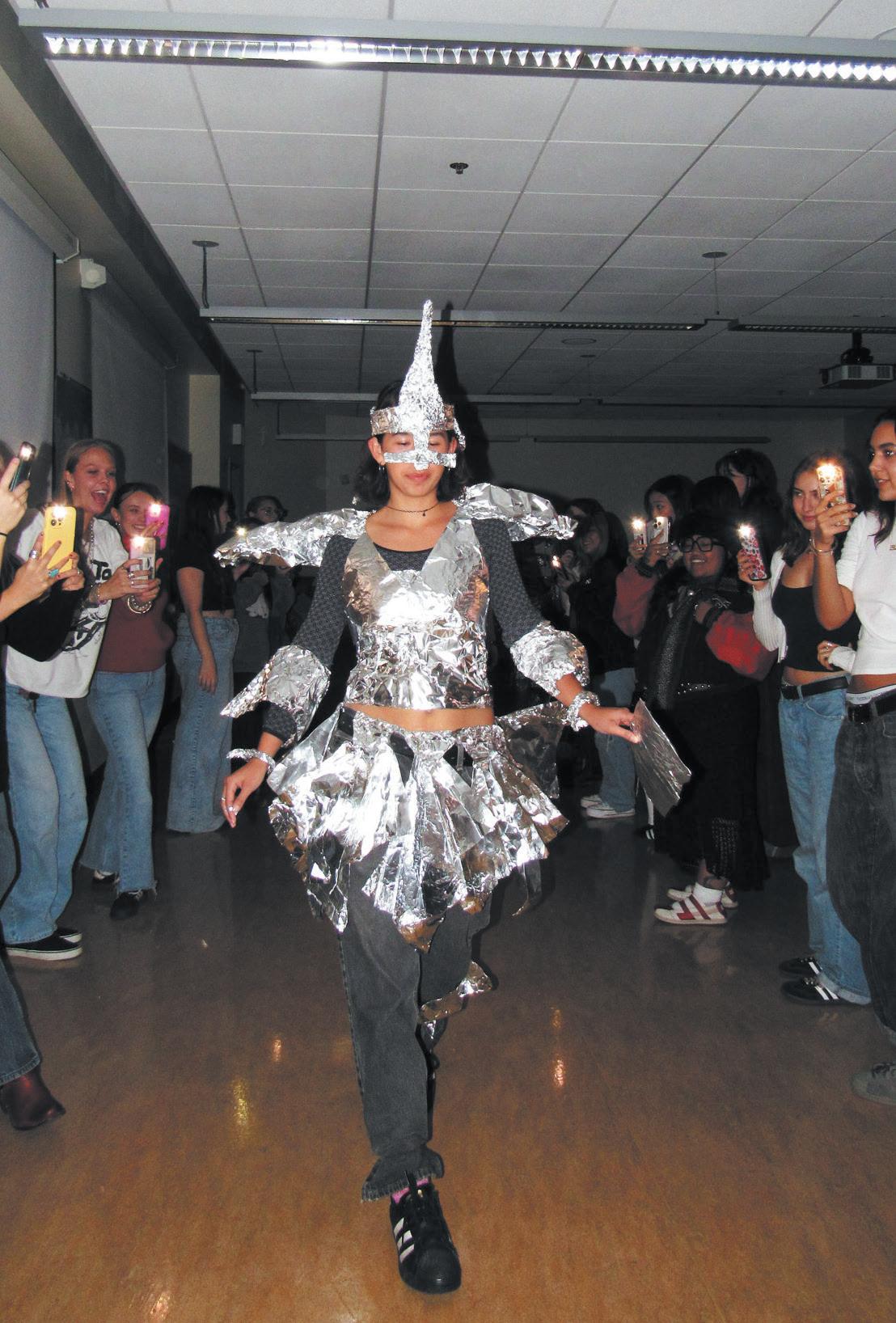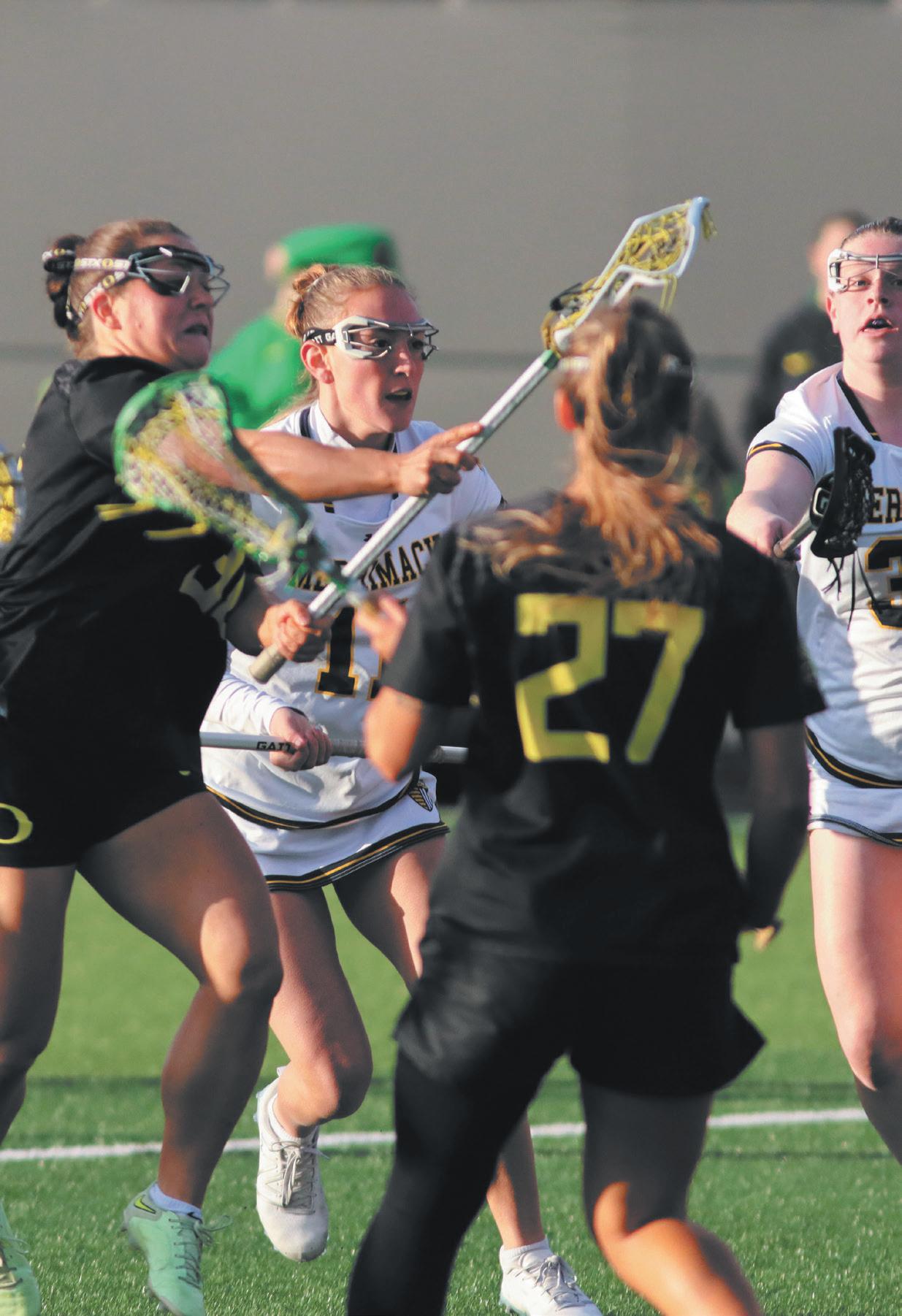









EDITOR IN CHIEF
Tristin Hoffman
PRINT MANAGING EDITOR
Mathias Lehman-Winters
DIGITAL MANAGING EDITOR
Alicia Santiago
CAMPUS NEWS EDITOR
Jasmine Saboorian
CITY NEWS EDITOR
Mathias Lehman-Winters
INVESTIGATIONS EDITOR
Tarek Anthony
A&C EDITOR
Jess McComb
SPORTS EDITOR
Brady Ruth
OPINION EDITOR
Beatrice Byrd
PHOTO EDITOR
Molly McPherson
COPY CHIEF
Olivia Ellerbruch
COPY EDITOR
Alex Woodward
VIDEO EDITOR
Kendall Baldwin
PODCAST EDITOR
Evan Giordano
SOCIALS EDITOR
Sydney Wolfe
VISUALS EDITOR
Noa Schwartz
DESIGN EDITOR
Sam Butler
DESIGNERS
Eva Andrews
Adaleah Carman
Taylor Grace
Olivia Hoskinson
Bella Lyon
PUBLISHER AND PRESIDENT
Eric Henry (X317) ehenry@dailyemerald.com
VP OPERATIONS
Kathy Carbone (X302) kcarbone@dailyemerald.com
DIRECTOR OF SALES & DIGITAL MARKETING
Shelly Rondestvedt (X303) srondestvedt@dailyemerald. com
CREATIVE & TECHNICAL DIRECTOR
Anna Smith (X327) creative@dailyemerald.com
STUDENT SALES MANAGER
Lola Tagwerker
ACCOUNT EXECUTIVES
Cooper Gast
Elliot Byrne Ysai Hong Nate Ghilarducci
The Daily Emerald is published by Emerald Media Group, Inc., the independent nonprofit media company at the University of Oregon. Formerly the Oregon Daily Emerald, the news organization was founded in 1900.
Emerald Media Group 1395 University St.,#302 Eugene, Or 97403 (541)-346-5511













The non-profit alleges some of the university’s scholarships that are given to women and students of color are in violation of the Equal Protection Clause
By Ysabella Sosa Campus News Associate Editor
The University of Oregon was named in a civil rights complaint on March 4 regarding four UO scholarships that allegedly discriminate based on race, color, national origin and/or sex.
The complaint, filed by the Equal Protection Project of the Legal Insurrection Foundation, a conservative non-profit that seeks to ensure equal protection under the law, said that UO’s alleged discrimination violates Title VI, Title IX and the Equal Protection Clause of the 14th Amendment.
According to the complaint, since UO is a public university, violating Title VI and Title IX directly violates the 14th Amendment.
The Equal Protection Project named four UO scholarships in the complaint, including the Robert J. Erickson Kaiser Permanente Scholarship and Maradel Gale Pacific Islands Scholarship, which both allegedly violate Title VI and the Miller Family Graduate Award in Technology & Science and Andrea Gellatly Memorial Scholarship, which both allegedly violate Title IX.
According to UO’s website, the Robert J. Erickson Kaiser Permanente Scholarship is intended to “encourage the higher education of students of color who are underrepresented in the college system.”
The complaint alleges that the “discriminatory factor” of this scholarship is that it states that “special consideration will be given to students who are Black/African-American, Hispanic/Latinx or Native American.”
The Maradel Gale Pacific Islands Scholarship “supports domestic or international students admitted to the University of Oregon, from the Pacific Island Nations (non-Hawaiian); with special preference given to those with proficiency in an Indigenous language.”
According to the complaint, the “discriminatory factor” of this scholarship is that an applicant must be a Pacific Islander student.
The Miller Family Graduate Award in Technology & Science is intended for graduate students who are pursuing research in technology or natural science, and there is a
“preference for female students.
The complaint alleges that the scholarship is discriminatory because it states it has a preference for female students.
The Andrea Gellatly Memorial Scholarship “is awarded to a woman beginning her final year in Clark Honors College who has demonstrated academic excellence, breadth of interest and social concern.”
According to the complaint, the scholarship is discriminatory because it states “woman beginning her final year.”
In an email statement to the Daily Emerald, William A. Jacobson, founder of the Legal Insurrection Foundation, called on the senior administration of UO to make sure “nondiscrimination standards are upheld throughout the university.”
On Feb. 14, the U.S. Department of Education Office for Civil Rights released a new guidance, clarifying the definition of racial discrimination.
The new guidance established that any “discrimination on the basis of race, color or national origin is, has been and will continue to be illegal,” which includes diversity, equity and inclusion programs. The complaint cited the new guidance as proof of how UO is allegedly violating the rights of individuals.
The Equal Protection Project concluded its complaint by asking the U.S. Department of Education’s Office for Civil Rights to open a formal investigation, impose “remedial relief” to those excluded from UO’s scholarships and ensure that all ongoing and future scholarships and programming “comports” with the U.S. Constitution and federal civil rights laws.
In 2025, the Equal Protection Project filed eight complaints against universities across the U.S., alleging each school has violated Title VI and IX for their racial-based scholarships or programs.
According to UO Spokesperson and Director of Issues Management Angela Seydel, the university has not received “official notification” of a complaint being filed.
“(UO) will respond to the Office of Civil Rights should they open a review,” Seydel said.
“Be mindful of things like: ‘Have I seen this person before?’ ‘Do they look like they’re middle-aged?’ ‘Do they have an ID on them anywhere?’ ‘Are they carrying a backpack?’ things like that, just being aware and familiarizing yourself with your floormates is good to do.”
- Emma Klausenburger, Graduate Student & RA in Carson Hall
““Talk to your RA or your hallmates and see if anyone knows them.”
- Jason Wade, UOPD Chief of Police
““If you see a crime being committed — such as laundry being stolen — call 9-1-1. Be prepared to say where you are and what you witnessed. If you got to the dryer and your things are gone call UOPD at 541-346-2919 to report the loss.”
- Jason Wade, UOPD Chief of Police
By Sasha Love Campus News Reporter
At least five incidents of trespassing, including three burglaries, have occurred since the start of February on or near the University of Oregon campus, according to an UO Alert sent on Feb. 26.
According to the alert, an unauthorized person entered Barnhart Hall’s 1st, 2nd and 4th floors on Feb. 25 and attempted to pry open 1st and 4th floor lounge doors.
The alert also said the same person involved in the Barnhart Hall incident and a second person are wanted for “questioning” in connection with two laundry burglaries at Carson Hall and Living Learning Center South during the week of Feb. 17.
On Feb. 18, a student living in Spencer View Apartments, an off-campus apartment complex, reported their bank card and key fob as stolen by a different suspect that has not been identified, according to a Feb. 21 UO Alert.
On Feb. 23, another suspect was found in Matthew Knight Arena men’s locker room who had “gathered items” and taken them to a bathroom stall, according to the Feb. 26 alert.
According to UO Spokesperson Eric Howald, the suspects gained access to residents’ floors when doors were held open for them.
“Holding a door for someone or even allowing them to skip using a key or keycard is an act of kindness, it’s commendable. It can also cause problems, as we saw here,” Howald said.
Sophia Goncalves is a freshman living in Carson Hall and neighbors with a resident who had their laundry stolen.
According to Goncalves, her neighbor originally thought their laundry was moved when the dryer timed out, before realizing the laundry was stolen.
Emma Klausenburger is a graduate student and an RA in Carson Hall.
Klausenburger said she’s been keeping an eye on her laundry more than usual.
“I was really scared to do my laundry for a little bit and I did it last night and I was literally like sitting in the lounge area just to wash my clothes to make sure that no one like no one came and tried to steal my stuff,” Klausenburger said.
Anna Schaffner, a freshman living in Barnhart Hall, said she was slightly concerned about the trespassing incident, but she was not surprised it occurred.
According to the Feb. 26 alert, the male suspect in the Barnhart, Carson and LLC cases is identified to be approximately 35 years old, and the woman suspect connected with the laundry incidents is approximately 25 years old.
Bryson Beck, director of promotions and student recruitment, said UO is “deeply concerned” about the recent incidents and emphasized that students should report “any and all” crimes to UOPD, even if they seem minor.
“We hope to prevent future occurrences by ensuring students are aware that these instances of trespassing can be prevented by not allowing folks to follow them into secured spaces in their buildings,” Beck said.



The law requires the automatic sealing of certain past evictions. Tenant advocates say the program is a “big deal” for renters.
By Lucas Hellberg City News Reporter
As of mid-December 2024, Oregon’s state courts have cleared roughly 47,000 residential evictions thanks to a law that state lawmakers passed two years ago.
The law, passed under House Bill 2001 in 2023, requires state courts to set aside or seal past residential evictions that meet specific criteria. Under the law, evictions that meet the criteria will no longer appear on a person’s publicly available record.
How the Eviction Record Clearance process works
Under the law, Oregon state courts are required to review and dismiss all residential eviction judgments prior to Jan. 1, 2014. In addition to those evictions, later evictions may be removed.
Oregon state court officials said the law may also dismiss other residential evictions. These evictions include eviction judgments without money awards that meet specific criteria. Court officials added that other residential evictions with money awards can also be cleared under the law. They said that if a money award for an eviction has expired, been paid or been discharged by a bankruptcy court, it may be eligible to be cleared under specific criteria.
But court officials said that if a money award for an eviction after Jan. 1, 2014 remains active, it is ineligible under the criteria.
Officials said that residential evictions in-
volving money awards where a court ordered someone to leave a property more than five years ago are eligible to be cleared under the law. In addition to those evictions, they said that residential evictions with stipulated judgments that happened at least 12 months ago are eligible to be cleared under the law.
According to the Oregon Judicial Department, a stipulated judgment is when two parties agree to resolve a case in a written agreement that a court approves.
Court officials said they are actively reviewing eligible evictions, starting with the most recent ones on people’s records. They said they are only at the beginning of the process.
In late January 2025, court officials reported a backlog of roughly 50,000 cases. Court officials said the goal is to finish reviewing all cases by the end of the year. After that, cases will be cleared annually.
Individuals can search for their eviction records using the Oregon Judicial Department’s free online records search tool.
Kevin Cronin is the director of policy and advocacy for Housing Oregon, a statewide association of housing nonprofits, organizations, companies and governments that advocates on the state and local level for policies and programs to expand affordable housing. Having experienced a no-cause eviction before himself, Cronin said the eviction-clearing program is a “big deal” for tenants who have faced similar challenges.
A new fire map has some residents concerned about the safety of their property, and the potential for rising insurance costs
By Ashley Davidson City News Reporter
The housing market in Lane County may be at risk, according to a recent analysis from the climate analytics firm, First Street.
According to the Property Prices in Peril report, 38.5% of properties in Lane County currently face flooding risks, a number projected to climb to 41.3% within the next 30 years. Property threatened by potential wildfires is even more pervasive, with an estimated 111,762 properties currently vulnerable — a figure expected to rise to 125,939 by 2055, which would amount to 80% of all properties in the county. These increasing climate threats could have serious economic consequences for Lane County residents.
It is possible that as buyers seek to avoid potential risks, the value of homes in highrisk locations may decrease. According to

Before the law was enacted, Cronin said that the only way people could get evictions cleared was through the courts, a step many renters were hesitant to take. Now, he said the eviction-clearing program does it “automatically.”
“Now, people have an easier time in the screening process,” Cronin said.
Cronin said the impact of the law goes beyond getting housing.
“Evictions can bring down someone’s employment chances,” Cronin said. “Evictions can also affect your credit.”
Tim Morris is the executive director of the Springfield-Eugene Tenant Association, a nonprofit organization dedicated to protecting renters’ rights. He echoed a similar opinion to Cronin’s on the prior process that required people to go to court to clear an eviction from their record.
In the past, Morris said that he has heard stories of people who had tried to go to court to get evictions cleared but, for “whatever reason, just didn’t go through.”
“But they moved on with their life …
and it was challenging,” Morris said.
Morris said the eviction clearance program also helps remove barriers for tenants with old evictions on their records, some of which they might not even know about.
“Sometimes, we heard on our hotline from tenants who weren’t even aware that they had an eviction that was 7, 8 or 10 years old,” Morris said. “They were denied over and over again for housing because of this extremely old eviction that they forgot about. They didn’t even know.”
Lane County Property Owners Association President Tia Politi commented on the impact of the eviction-clearance program in relation to tenant screening. She said it doesn’t significantly change how landlords evaluate tenants since they already could not consider older or dismissed evictions.
“This doesn’t really affect landlords at all,” Politi said. “But I think it does affect tenants ... It’s a positive impact for a renter who’s had an eviction in their past. It’s kind of like the scarlet letter.”
the analysis, if risk-based pricing is fully implemented, insurance rates will increase by 29.4%, making homeownership more costly. This may make it more difficult for first-time buyers to enter the market due to rising insurance premiums and concerns about property depreciation.
“Looking at the report it definitely brings up the idea of relocating,” Lane County resident Craig Olson said. “In the past, issues like climate haven’t been a huge concern, but the more talk I hear, the more I start to be concerned,” Olson said.
Despite these concerns, the Lane County housing market remains active. Recent data from the report shows that median list prices have risen, and the number of available listings has increased. Additionally, Eugene’s market competition index has seen a steady climb, indicating continued demand for housing in the area. However, as this re-

port is still new, concerns from some homeowners and renters are starting to rise.
“If I wasn’t already planning on moving I feel like this would be a big concern for me,”
Coos Bay resident Jamie Gatewood said. “If you look at what has been happening with the fires in (Los Angeles) and the issues with what insurance was and was not able to cover for those victims, it doesn’t give me much faith for if something like that were
to happen here.”
Although the real estate market in Lane County is currently doing well, firefighters and insurance companies advise that prior planning is crucial. The long-term impacts of rising climate hazards may be lessened with investments in fire-resistant infrastructure, revised zoning regulations and homeowner education on climate resilience.
A quick breakdown of different AI-related policies from various departments at the University of Oregon.
UO says it “strongly encourage instructors to have an explicit policy about GenAI in their course syllabus, including any relevant distinctions between GenAI use (as process) and GenAI content (as product).”
UO advises that these aspects be included in course syllabi:
Use citations and be transparent in your usage.
Make all information human-reviewed.
Be aware of the potential bias that generative AI possesses.
Respect the privacy of individuals and the UO.
UO states some appropriate uses for AI:
Summarize large texts
Help with brainstorming
Compile public web content

Some college students have resorted to relying on ChatGPT or other AI platforms for help with their assignments. While AI has a number of benefits, there are some critical issues we need to be aware of like privacy laws and misinformation.
By Daria Morris Opinion Columnist
In the spring term of my freshman year of college, I finally gave in to using artificial intelligence platforms to help me understand some of my more difficult coursework. I successfully never used it until I started taking science classes here at University of Oregon. But, as soon as I was stuck trying to decipher one of my complicated assignments for my anthropology lecture, I asked for a chat to explain the criteria in simple terms.
laziness and 27.7% of the loss of decision-making skills were the result of artificial intelligence use.”
Jessica Talisman, a senior information architect for Adobe, works primarily with AI platforms. She has produced several podcasts relating to the subject of AI, such as “The AI Digest,” as well as “Data Dialogues,” a podcast about navigating the data landscape and “The Data Democracy,” a podcast about educational neuroscience.
I asked Talisman what she thought the biggest concerns were for students at UO using AI platforms and what they should be cautious about.
“It is a large language model, (or) what is known as LLM. It is a statistical model, not a number model. It is notoriously terrible with numbers, security, data, data analytics and realistically is only a sophomore to junior level when it comes to data coding,” Talisman said.
“AI such as ChatGPT has a lot of disinformation, misinformation and bias. Be careful about fact-checking; it is known to have hallucinations. In other words, it can be seen as AI’s creative agency, meaning that it can get very creative and make things up that are not factual,” Talisman said.
Talisman also talked about potential student overuse of ChatGPT and other AI-related platforms, which may reduce their ability to learn.
“There are a lot of academic scholarly publications that prove there is a broad range of cognitive offloading. Critical thinking is one of the main objectives of education. It is the mission of the university. If critical thinking is obstructed, then your brain fails to develop knowledge, handle tasks and synthesize knowledge,” Talisman said.
According to Talisman, ChatGPT is a profitable open-access AI platform, which is a contributing factor to why it isn’t as trustworthy. Additionally, it has its privacy issues such as collection of sensitive data, collection of data without consent, use of data without permission, unchecked surveillance and bias, data exfiltration, and data leakage.
- Jessica Talisman, Senior information architect for Adobe
“ “ AI such as ChatGPT has a lot of disinformation, misinformation and bias...In other words, it can be seen as AI’s creative agency, meaning that it can get very creative and make things up that are not factual.
Since then, I have used AI platforms to grammar check some of my assignments and essays, summarize instructions for homework assignments, help me create thesis statements for essays and generate ideas for my argumentative articles. For me, it has reached a point where I use it at least once a day. Nowadays, I rarely go through and grammar-check my work myself.
I think there are plenty of benefits to ChatGPT, Grammarly, Gemini and other AI platforms, especially in an academic setting. AI is often referred to as a “modern approach to learning,” allowing us access to a wide range of tools for certain aspects of our class work.
I don’t mean cheating. However, I know that myself and some other UO students have a tendency to lean on AI way too much for help, and there are negatives to that. A study performed by Dr. Mohammed Ahmed, who worked as an assistant professor in engineering management at Eastern Michigan University, showed that not only is AI reducing our critical thinking skills, otherwise known as cognitive offloading, but open access AI is not always reliable.
Leanne Fan, a journalist for the Nexus reported Dr. Ahmed’s findings. “Survey data from 285 students found that 68.9% of
51% of young people ages 14–22 reported using generative AI at some point, but only 4% claimed to be daily users.
*
I became curious about how professors at UO feel about ChatGPT and its use in the classroom. I asked Professor Mark Blaine, who works in the SOJC department teaching journalism classes and is known for his documentary work, about AI. He said that he believes AI is both a positive academic attribute and has some major downfalls.

Daria Morris is an opinion columnist for the Daily Emerald. She is a secondyear student at the University of Oregon majoring in journalism and communications with a minor in creative writing. Daria likes to write about feminist topics as well as deep topics that are related to students' well-being on campus.
53% reported that they commonly use AI for getting information.
“I probably use ChatGPT in way too many areas in my life. If I feel stuck on schoolwork or in need of inspiration, I quickly ask ChatGPT, which I find always helps get the creative wheels turning for me. I definitely feel the majority of students overuse it, and that could be harmful to learning, but at the same time, I feel it is smart to use the resources that are at our disposal,” Schlecht said.
A short guide, compiled by the Daily Emerald’s opinion desk, on how to use AI responsibly without compromising learning.
Blaine discussed student reliance on AI tools and the ways this impacts education.
“If you’re leaning on it too hard when you’re not exercising the muscles you’re supposed to be using while you’re here, you can’t expect to become a better writer. It might give you the right answers, but that is not what we are looking for here,” Blaine said. Blaine talked about the issues students may face when looking for jobs in the future, especially with portfolio building. “You are going to be judged on what you produce. If that production suffers from the use of AI, it is going to make you less competitive, not more competitive.”
Blaine also had some thoughts on how he has seen students use AI platforms, especially when it came to writing papers for his classes.
51% reported that they commonly use AI for brainstorming.* *
“Some were good, some were a pain to read, but when you have to turn in a really long dry report or some sort of technical material, it gets you to an answer really fast. In other cases, that doesn’t pass the sniff test,” Blaine said.
I have personally seen students use ChatGPT and other AI platforms in class to help understand assignments, help with homework, asking AI to summarize articles, etc. I am not ‘dissing’ these individuals because I understand how difficult and stressful classes can get. When it comes to my personal experience using these AI platforms, I noticed that once I started using AI for academic assistance it started becoming hard not to use it for basic assistance.
UO sophomore Campbell Schlecht talked about her use of AI tools.
I asked Campbell what she typically uses ChatGPT or other AI platforms for. “The main area in my life that I don’t and probably would never use is for my current job as a promotions assistant,” Schlecht said.
“ “ I definitely feel the majority of students overuse it, and that could be harmful to learning, but at the same time, I feel it is smart to use the resources that are at our disposal.
Following these techniques when using AI with your schoolwork can help ensure you’re not compromising your learning:
Use it for assistance, not for reliance.
Make a habit of checking all information given to you.
- Campbell Schlecht, UO Sophomore
While there are plenty of benefits to ChatGPT and other AI platforms for students in terms of supplying resources, it seems like the student use of AI isn’t being managed properly. Even so, it would be hard to manage.
My goal is to reduce the amount of assistance I rely on AI for when it comes to understanding an assignment and helping me come up with a thesis, and I know many other students over-rely on it too for many different reasons. While there are plenty of net-positives about these platforms, there are also many net-negatives that may personally affect you and make the platforms unreliable.
*
Information taken from a quantitative study done by Harvard University
Know the depth of your own creativity.
Understand that it is a tool, but it has many flaws.
Track your usage and notice when you may use it too often.
Now more than ever, we need to take action and protect our national parks
Four years, 141 days, 14 hours, 8 minutes, & 30 seconds.
On March 2, at the time of writing this article, that is the current Climate Clock countdown time. The Climate Clock refers to the remaining time available for humans to significantly lower their carbon emissions before irreversible damage is caused to the Earth.
Climate change is one of the most pressing global issues today, and the Trump administration’s dismissal of this scientifically supported concept is damaging for the future of our planet.
Damaged ecosystems such as national parks can affect the essential resources that all living organisms need to survive like clean air and water. As humans, our well-being and the way our society functions is at risk due to climate change. This risk will continue to grow with each harmful decision President Trump makes.
On Feb. 14, the Trump administration laid off thousands of Park Service and Forest Service employees which has left many Americans, including myself, fearful of what will happen to our national parks.
University of Oregon junior and environmental science student Alice Tabor explained the importance of national park employees.
“Even though national parks look like wilderness, they are still contained and run by humans,” Tabor said. “There is risk involved, for humans specifically, if people are hiking in dangerous conditions. There are a lot of threats and if the national parks are going to be understaffed, then there are going to be a lot less people available to help.”
National park employees help manage our parks and their wildlife. Without these essential personnel, fewer people will be able to visit the parks, and the other staff will have to work harder to manage the land.
These effects have already occurred in national parks such as Zion, Yosemite and the Grand Canyon. Visitors have reported waiting for hours to enter parks since the entry points only have one to two working staff members.
In addition to long wait times, many visitor’s centers have reduced their hours which will affect the educational distribution about each specific park.
Following these changes, protesters are appearing at various national parks such as Joshua Tree, the Grand Canyon and Yellowstone to voice their concerns
about how these personnel cuts will negatively impact the environment and park conditions.
For instance, on Feb. 22 protesters in Yosemite flew an American Flag upside down to symbolize their distress.
Lake Clark National Park workers Eileen and James Kramer were terminated in February by the United States Office of Personnel Management. This couple pursued legal action claiming they were fired under the false pretense that they were underperforming.
The judge ruled that the Trump administration’s Office of Personnel Management overextended its power; the Kramers’ terminations were not based on job performance.
UO sophomore and outdoor enthusiast Marco Montemore explained his ideas for why the Trump administration has made job cuts to national park employees.
“They’re (the Trump administration) trying to thin staff management and make it seem as though the parks are underused and that the public spaces need to be optimized in terms of their usefulness through new programs of harvesting resources,” Montemore said.
“For specificity, certain places in Oregon are going to be opened up to the timber and logging industry.”
The administration’s decisions, such as the executive order President Trump signed on March 1, will increase timber production. This presidential order directly counters environmental policies to protect certain species and forests in the Pacific Northwest.
In order to prevent the president’s overreach of power, we the people need to voice our opinions though protesting, lawsuits, petitions and by reaching out to our government representatives. The natural world is at risk now more than ever, and it is our duty as civilians to protect our forests, national parks, and other ecosystems in the United States.
By Lexi Smith, Opinion Columnist




Lexi is an opinion writer for the Daily Emerald. She is a second-year student studying journalism and psychology. Lexi enjoys writing about social topics such as pop culture.
2,000 probationary Forest Service
Crater Lake is the 5th oldest national park in the United States, and Oregon’s only national park There are 63 national parks in the United States



Didn’t float
Mauna __: only Hawaiian volcano taller than Mauna Loa
Last minutes of a blowout game
“__ away”: “I have nothing to hide”
Preworn, say
Subway tracks
Permanent mark
Pen point
Census figures
Excuse 64 Taunts between teams, or an apt description of 16-, 29-, and 48-Across?
Walkie-talkie, e.g.
Roof overhang
Leg bender
Brain waves
Genetic material
Small whirlpool
Winter forecast, often
Crow “In your face!,” say
Body part that’s a metaphor for
Misplace
1 Some QB protectors
Eyebrow shapes
Spot where cocktails may be shaken or stirred 4 Practices in the boxing ring
5 Preferring platonic relationships, informally
6 Desktop image
7 Stubborn reply to a direct order
8 Govt. org. that regulates vaccines 9 Gym feature for indoor climbers 10 Pro’s opposite
Cattle sounds 12 Is off the mark
Gets
Yanks 21 Poetic “above”
24 Put an end to 26 “Srsly!?”
27 Fix, as computer code
28 Hawaiian hello
30 Surprise in a plot
31 Defended one’s point of view
32 Makes less difficult
33 Cut of beef, tuna, or cauliflower
38 Collection of bedroom communities
40 Hair removal brand
41 All together 44 __ Vegas 46 Country singer Urban 49 Intro to Xer, Yer, and Zer
Potato pancake
Diwali dress
Dressed (in)
Winter conveyance
Apple platform 65 Hannah Einbinder’s “Hacks” role
__ lime pie
By Cass Morrison Arts & Culture Writer
Since the beginning of fall term, the growing presence of the University of Oregon Fashion Club has reverberated across campus. After being inactive during the winter and fall of 2024, the club has experienced a resurgence in engagement under the leadership of Lauren Bullard, a second-year business student specializing in marketing, who took over as the club’s president at the start of the year.
Bullard said she wants to create a welcoming environment that challenges the exclusion and pretentiousness often found in fashion communities. She initially struggled with outreach because she wanted to project a club identity that appealed to a variety of different groups.
“After a while, I was like, ‘I’m just gonna kind of do what I think looks good and certainly that’ll appeal to someone,’” Bullard said. “And I think it has because overall engagement has definitely increased.”
The club often organizes hands-on activities for its meetings, such as a tote bag accessorization workshop in homage to Jane Birkin, to ensure that the environment remains accessible to all. The DIY workshops offer a space for people to express their enthusiasm for fashion and avoid the pressures of seminar-style meetings.
“Fashion is just a scary place, and I think that deters people from interacting in meetings,” Bullard said. “But we’re just people at the end of the day.”
Since the university does not offer a fashion program, Bullard’s goal is to create a tangible space that unifies the local fashion scene. She hopes that fostering an environment that is both
inclusive and informative will nurture the evolution of the UO fashion community.
A dual-focused content strategy on social media has been a key factor in the club’s newfound relevance in the community. The club’s account posts educational content, breaking down iconic archival looks and current trends, but it also consistently features student outfits, which has proven highly effective at generating engagement.
Bullard said this approach inadvertently targets friend groups because when people see their friends featured, they often tag them, increasing post interaction. UOFC is more concerned with people’s unique personal style than esoteric fashion knowledge.
“There is this misconception when it comes to fashion that you need to have some grandiose knowledge coming into it,” Bullard said. “But you really don’t. Everyone has an eye for something, and everyone has their own take on what looks good.”
There are no prerequisites to joining the club. “Even if you just come to one meeting and don’t come to the rest for the term, you can still consider yourself a member,” Bullard said.
Club meetings, which used to average around five to 10 attendees, now see upwards of 20 to 30 people each session. Bullard said the experience has taught her patience, comparing the progress of the club throughout the past two terms to experiencing growing pains.
Moving forward, Bullard’s goal is to make fashion seem more feasible at state schools without designated fashion programs. While her current focus is building a community, the eventual goal is to offer members a bridge into the real fashion world by featuring guest speakers and connecting members with professionals in the industry.
The University of Oregon’s Fashion Club is destigmatizing conversations around fashion. Through inclusivity and education, the club imagines a bright future for the fashion scene in Eugene.

Visit the JSMA’s most recent exhibit and understand the importance of transience and perspective in the world of AI through the lens of Chinese contemporary art
By Mark Munson Arts & Culture Writer
Change is in the air. With daylight savings approaching and flowers blooming in the gaps between campus walkways, seasonal transience is on full display. While hearts may warm with joy as icy mornings fade into sunny days at Dexter Reservoir, the days spent chasing powder at Mt. Bachelor and surrounds are the inevitable sacrifice. Such bittersweet feelings are encapsulated within the light writing of renowned contemporary Chinese artist Qiu Zhijie, now on display in the Jordan Schnitzer Museum of Art.
Qiu Zhijie has been a prominent name in the Chinese contemporary art scene for
over three decades. From his first video exhibition in 1996, his role as an innovator in the contemporary art scene is undeniable. As president of the Tianjin Academy of Fine Arts and a curator in his own right, Zhijie boasts a multidisciplinary portfolio covering a variety of mediums.
But when he introduced himself during his Feb. 2 panel at the JSMA, Zhijie characterized himself so the audience could understand his work. “I’ve always been asked who I am,” Zhijie said. “I am a mapper.”
For Zhijie, concept mapping is the combination of all his facets, a flow of curation, calligraphy, painting and journalism. He works in cartography both physically and conceptually. His work in physical car-

tography gained traction in 2017 following the release of “Map of the Theater of the World” at the Guggenheim Museum which led to many iterations involving concepts like technological ethics.
But broadly, his portfolio reflects a conceptual cartography, mapping the reality of a world straying from tradition and in the process of being overturned by AI.
As uncertainty continues to bombard the West, the choice of Yan Geng, a new curator for the JSMA, to display “Twenty-Four Seasons: Critical Temporality and Qiu Zhijie’s Light Writing” brings ideas of transience to the forefront of the Eugene community.
“Qiu Zhijie is particularly interesting because he is not making the Chinese tradition something exotic or superficial,” Geng said. “He is using Chinese media with contemporary artists from other nations to deeply engage with some of the fundamental issues in contemporary art.”
By ignoring the perception that photographs are captured moments and exploring the process of writing calligraphy, Zhijie addresses the matter of transience with his light writing.
“Photography is not just about a moment,” Geng said. “It’s about a process and this process he was exploring is the process in which he was writing calligraphy.”
By engaging with his own cultural background, Zhijie provides a critical perspective of photography by which to push the medium forward.
Calligraphy, which Zhijie dissects, has a storied history as the first Chinese fine art and remains highly regarded today.
“Even until now, the traditional view on fine art has remained the same. The order of the most important fine art starts with poetry, then calligraphy (and) then painting,” Johnson Chang, a prominent curator and dealer of Chinese contemporary art, said during the JSMA panel on Feb. 2. “Almost all of it has to do with the written word, even painting, the aesthetics of painting has been founded on the brushwork and how the painter delivers his personality so in that sense Qiu Zhijie has basically unravelled the magic of the written word.”
“He has a very ambitious plan and an interest in exploring AI in a more complicated way,” Geng said. “So for him, the AI is not just asking DeepSeek to generate an image, he is deeply interested in AI in the sense of art and technology and neuroscience and the study of the human beings.”
Zhijie has taken a truly experimental approach, using concepts of neuroscience to teach AI robot arms how to write his calligraphy and even attempting to create an AI version of himself by compiling his portfolio and plugging it into the neural network. Understanding the future lies in interdisciplinary collaboration, and Zhijie has enlisted a wide variety of professionals from neuroscientists to computer and natural scientists to contribute to the project. This collaborative approach provides respite from the storm of technological and cultural change currently engulfing the world. It shows that through comradery and connection, humanity can embrace the ephemeral and tackle global issues together. The exhibit will be open until June 22.










The lacrosse midfielder started the season off in a historic fashion
By Lily Crane Sports Reporter
It only took 10 seconds for Oregon lacrosse’s Anna Simmons to storm down half the length of the field and score.
It was the first time that Simmons found the back of the cage in her program record-tying seven-goal performance against Stetson University on Feb. 11.
Causing opposing defenses to scramble and then shake their heads after inevitable defeat is something that the junior midfielder has done in just about every game this season. Her team-leading 24 goals through six games follows a career-best 34 goals she scored last season in 15 outings.
“From freshman year to sophomore year, I made a huge jump, and sometimes I wasn’t super confident in myself,” Simmons said. “In this off-season, I just learned how to trust myself and be able to push myself to new levels while also bringing people with me, so not only that I’m performing, but more people are as well.”
When Simmons is playing well, whether it’s on defense or offense, opportunities open up for the rest of her teammates. In the game against Stetson, sophomore attacker Avery
Young also contributed four goals.
“(Simmons) came up to us maybe after a couple shots in the first quarter and was like, ‘They’re getting tough on me. You guys have to step in and take that role, and not just on offense,’” Young said. “That’s just being communicative and being like, okay, if she’s not going to get it in, we have to.”
Simmons’ offensive showing has garnered a lot of attention from fans and the Big Ten, but she’s dominated both sides of the field. In addition to her seven goals against Stetson, she recorded a career-high seven ground balls and a career-high of five caused turnovers against Central Michigan University.
“We’ve really focused on the small wins like those little ground balls or chasing the shot after someone misses,” Simmons said. “Those things really help us create momentum. I think that’s why we are finding success on offense and defense.”
Her dominant performances made her the only player in the Big Ten to win the Conference Midfielder of the Week award in the first three weeks of the season. The Ducks got off to a 4-0 record before losing two games on the road.


By Joe Krasnowski Sports Reporter
In the months before, the longevity of the softball season seems more abstract, with each game of Oregon softball’s 57-game regular season representing an equal 1.85% of the season. When teams are in the lengthy grind of it, the “tomorrows” and “next weeks” leave players lacking any real finality.
But with that slog of the schedule comes the moments to take a step back and reflect on a team’s current standing. Oregon softball (20-1) is about a third of the way through its season, which means it’s no longer too early to reflect on Oregon’s hot start — one that includes the team’s longest winning streak since 2021 (15).
WHAT’S REAL:
The freshman
Biggest, strongest, fastest. Pick your superlative for Oregon’s freshman class — they all seem to work. Oregon’s freshman class has solidified itself as one of the best in the nation in the early going. Rylee McCoy looks like one of the best first basemen in the country. Stefini Ma’ake is a power threat every time she’s at the plate. Despite being out with an injury in the short term, Emma Cox looks like an everyday starter behind the plate for the next three years. The depth is there, too — Kaylynn Jones has taken quality atbats and walked over 20% of the time. Oregon’s biggest strength has been its freshman class this year, and they will only get better with time.
Lyndsey Grein
Grein’s stuff and demeanor on the mound are legitimately special. Throughout her 54 innings of work on the season, Grein’s stuff has been seen to be legitimately special. She gets swing-and-misses on pitches on her poorly located pitches and sets up everything else off her
How legit are these Ducks?
fastball. It’s clear her stuff will translate against better competition, too. Oregon softball has a legitimate superstar ace on its hands in the Virginia Tech transfer.
The speed
Oregon leads the NCAA with 81 steals. Head coach Melyssa Lombardi’s Ducks can fly.
CAUSE FOR CONCERN:
Overall pitching depth
Two things can be true: Oregon softball’s pitching has been elite — excelling to the tune of a 1.71 combined ERA, 10th best in the NCAA. The Ducks also need a legitimate fourth option in the circle. Grein, Taylour Spencer and Elise Sokolsky have been incredible for the Ducks. But Oregon needs either lefty Staci Chambers (2.07 ERA last season, hasn’t pitched since Feb 8 due to injury) or freshman Rowan Thompson (0.1 innings pitched, three walks) to regain form before conference play.
WHAT NEEDS MORE TIME:
Offensive woes against quality opponents
Drowned out by the Ducks’ marquee 1-0 win over then-No.5 University of Tennessee was that the Ducks had one hit against the Lady Vols. Time will tell if the cause for concern is legitimate — Oregon’s offense has been good against other quality competition. But, in the Ducks’ first test against the truly elite, they no doubt struggled.
OVERALL:
Go on, do it. Feel good about these Ducks. With the Ducks meshing well in the early going, there’s real reason to be excited about Oregon softball this year. It might not always be perfect, and there will surely be some growing pains. But a third of the way through the season, there’s plenty of optimism — and for good reason.
